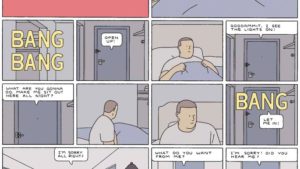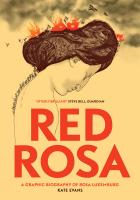
A review of a new contribution to the field of comics studies.

Sabrina, a graphic novel by Nick Drnaso, is the first graphic novel to be long listed for the Man Booker Prize in the award’s long history. It came as a surprise to many of the loyalists of the literary community . . .

In South Africa ten members of a militant shack dwellers organisation have been assassinated in the past six years. Yet many progressive organisations have distanced themselves from these militants. Jared Sacks exposes the complicity of a mainstream NGO that could have played an important role defending the movement against these political assassinations. Sacks argues that when movements refuse co-optation, repression, including assassination, become necessary to maintain power.

This season’s roundup of nonfiction comics includes self-published and small-press titles as well as noteworthy releases from major trade publishers. Topics covered range from consumer capitalism and imprisoned anarchists to Trinidadian social history and the war in Syria. Each of these titles deploys a distinctive approach to the challenge of folding political themes into visual narrative. In different ways, these books suggest that the forward march of political cartooning continues unabated.

The closing of the era when comic art specialists, not people with PhDs, wrote the outstanding and recognized works on individual artists and genres may have arrived as recently as only a few years ago. Careful biographies of artistic giants, household names (in their own eras, at least) or famed only within the field, Al Capp or Will Elder, have continued to be written by people who could rightly be called “fans”—if the title did not seem insulting. Rather than university presses, Fantagraphics or the comics series at Abrams would be a typical outlet. With each year that passes and with each swelling enrollment in a college course, the scene shifts.
In her award-winning book Red Rosa (2015), Kate Evans combined feminist biography, intellectual history, and appealing visuals to tell the remarkable story of Rosa Luxemburg. While much of the narrative focused on friendships, relationships, and personal struggles, Evans also conveyed a sense of Luxemburg as a theorist of capitalism, imperialism, and war.

Red Rosa: A Graphic Biography of Rosa Luxemburg, Kate Evans, Verso, 2015, paperback, $16.95
Capitalism and Climate Change: The Science and Politics of Global Warming, David Klein (author) and Stephanie McMillan (editor and illustrator), Amazon digital services, 2015, eBook, $2.95
Gene Basset’s Vietnam Sketchbook: A Cartoonist’s Wartime Perspective, Thom Rooke, Syracuse University Press, 2015, paperback, $24.95
My War, Szegedi Szüts, Dover, 2015, paperback, $12.95
The graphic lit juggernaut rolls on. Even as DC and Marvel crank out superhero comics at roughly the same pace they have for the past twenty or thirty years, trade publishers and university presses are issuing nonfiction narrative art on a scale that would have been unthinkable a decade ago. Back in the day, the four books under review would have represented a significant percentage of like-minded cartooning to appear in any given season. Now practically every publishing house under the sun boasts a new graphic novel line or at very least a fistful of titles aimed at the words-and-pictures market.
 Wonder Woman was not the first female superhero, but she is the best known of the modern-day costumed heroines. Armed with indestructible bracelets, her Amazonian heritage, and a “magic lasso,” the character’s inaugural debut came in the pages of All Star Comics #8 in December 1941; a month later she was showcased on the cover of Sensation Comics #1.
Wonder Woman was not the first female superhero, but she is the best known of the modern-day costumed heroines. Armed with indestructible bracelets, her Amazonian heritage, and a “magic lasso,” the character’s inaugural debut came in the pages of All Star Comics #8 in December 1941; a month later she was showcased on the cover of Sensation Comics #1.
The cartoonist Will Eisner used to say that there are two kinds of comics, entertaining and instructional. Over time, he speculated, instructional comics would become the more popular of the two, as teachers and everyone else finally figured out that comics convey information more efficiently than ordinary prose. Eisner passed away in 2005 but presumably would have regarded the past decade’s outpouring of graphic nonfiction as confirming his thesis.
The most vivid and without a doubt, the most disliked (make that, hated) comic-artist critic of Jewish power plays, from Tel Aviv to Los Angeles, Eli Valley ranks high among the most Jewish comic artists anywhere in the world today.
The Marxists Internet Archive project recently uploaded the complete run of Labor Action, published by the Workers Party and its successor, the Independent Socialist League, between 1940 and 1958, as well as the Militant, published by the Socialist Workers Party.
Which came first, your interest in politics or your interest in cartooning?
They actually began together, when I was 13 or 14, with a badly drawn, over-the-top, heartfelt diatribe against my mother’s consumerism. Even though I was just a white, middle class teenager in Connecticut, I was indignant about inequality and injustice.
How did you get started as a political cartoonist?
Former New Politics editor Kent Worcester has written a nice appreciation of New Politics and its covers by Bob Gill.